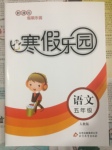题目内容
书面表达
假如你是中学生李华,你校外教Mary女士近期准备回英国度假,为此,你班同学准备开一个晚会为她送行。请你根据以下提示,用英语写一封邀请信。
对她的教学表示感谢。
时间:本周日晚上7:30开始,预计持续1个小时。
地点:高三10班教室
活动:唱英文歌,送鲜花等
注意:1. 词数100左右。
2. 开头和结尾已经给出,不计入总词数。
3. 可适当发挥,使行文连贯。
Dear Mary,
We hear that you’ll return to the United Kingdom on a holiday soon.
___________________________________________________________________________________
___________________________________________________________________________________
___________________________________________________________________________________
Yours truly,
Li Hua
练习册系列答案
 寒假乐园北京教育出版社系列答案
寒假乐园北京教育出版社系列答案
相关题目


